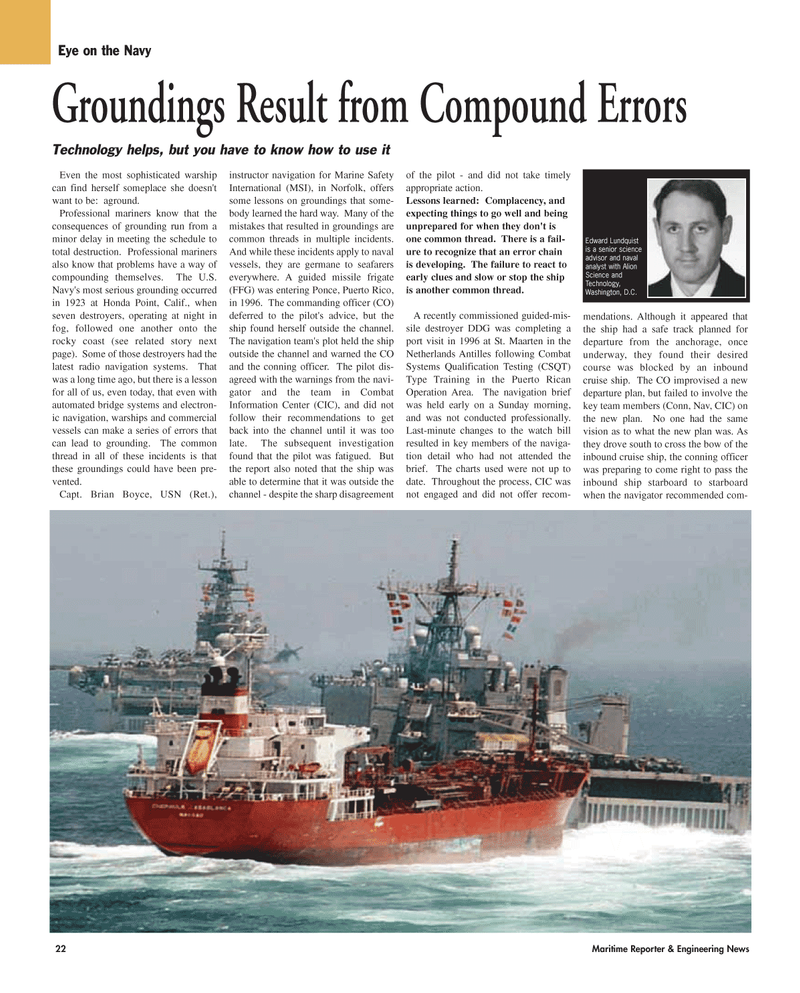
Page 22: of Maritime Reporter Magazine (July 2005)
The Satellite Communications Edition
Read this page in Pdf, Flash or Html5 edition of July 2005 Maritime Reporter Magazine
Even the most sophisticated warship can find herself someplace she doesn't want to be: aground.
Professional mariners know that the consequences of grounding run from a minor delay in meeting the schedule to total destruction. Professional mariners also know that problems have a way of compounding themselves. The U.S.
Navy's most serious grounding occurred in 1923 at Honda Point, Calif., when seven destroyers, operating at night in fog, followed one another onto the rocky coast (see related story next page). Some of those destroyers had the latest radio navigation systems. That was a long time ago, but there is a lesson for all of us, even today, that even with automated bridge systems and electron- ic navigation, warships and commercial vessels can make a series of errors that can lead to grounding. The common thread in all of these incidents is that these groundings could have been pre- vented.
Capt. Brian Boyce, USN (Ret.), instructor navigation for Marine Safety
International (MSI), in Norfolk, offers some lessons on groundings that some- body learned the hard way. Many of the mistakes that resulted in groundings are common threads in multiple incidents.
And while these incidents apply to naval vessels, they are germane to seafarers everywhere. A guided missile frigate (FFG) was entering Ponce, Puerto Rico, in 1996. The commanding officer (CO) deferred to the pilot's advice, but the ship found herself outside the channel.
The navigation team's plot held the ship outside the channel and warned the CO and the conning officer. The pilot dis- agreed with the warnings from the navi- gator and the team in Combat
Information Center (CIC), and did not follow their recommendations to get back into the channel until it was too late. The subsequent investigation found that the pilot was fatigued. But the report also noted that the ship was able to determine that it was outside the channel - despite the sharp disagreement of the pilot - and did not take timely appropriate action.
Lessons learned: Complacency, and expecting things to go well and being unprepared for when they don't is one common thread. There is a fail- ure to recognize that an error chain is developing. The failure to react to early clues and slow or stop the ship is another common thread.
A recently commissioned guided-mis- sile destroyer DDG was completing a port visit in 1996 at St. Maarten in the
Netherlands Antilles following Combat
Systems Qualification Testing (CSQT)
Type Training in the Puerto Rican
Operation Area. The navigation brief was held early on a Sunday morning, and was not conducted professionally.
Last-minute changes to the watch bill resulted in key members of the naviga- tion detail who had not attended the brief. The charts used were not up to date. Throughout the process, CIC was not engaged and did not offer recom- mendations. Although it appeared that the ship had a safe track planned for departure from the anchorage, once underway, they found their desired course was blocked by an inbound cruise ship. The CO improvised a new departure plan, but failed to involve the key team members (Conn, Nav, CIC) on the new plan. No one had the same vision as to what the new plan was. As they drove south to cross the bow of the inbound cruise ship, the conning officer was preparing to come right to pass the inbound ship starboard to starboard when the navigator recommended com- 22 Maritime Reporter & Engineering News
Eye on the Navy
Edward Lundquist is a senior science advisor and naval analyst with Alion
Science and
Technology,
Washington, D.C.
Groundings Result from Compound Errors
Technology helps, but you have to know how to use it
MR JULY2006 #3 (17-24).qxd 7/5/2006 11:42 AM Page 22

 21
21

 23
23
